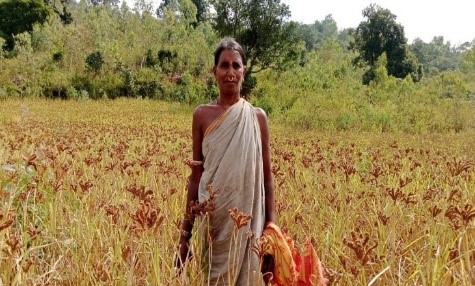Brunda Pangi: Tribal-Trailblazer
A Tribal Woman Farmer Cultivating a Better Future
Brunda Pangi, a 50-year-old tribal woman farmer from Bijaguda village of Lamtaput block, Koraput district, she became a hope and inspiration for sustainable farming. Born and raised in a farming family, she always had a deep connection with nature and agriculture. She lives with her husband, son, daughter-in-law and grandson. She owns two acres of land, with one acre being low land and the other middle land. Over the years, she witnessed the harmful effects of chemical-based farming practices on soil fertility, biodiversity, and human health. Determined to bring about a positive change, she took a bold step toward organic farming.
The Journey to Organic Farming

Previously Brunda Pangi had been relying on chemical fertiliser and pesticides to manage her crops. However, she had begun to notice the negative impact of these chemicals on soil, water and overall health. After receiving training programs from the project Samposhan, M.S. Swaminathan Research Foundation (MSSRF) on organic farming, use of Organic formulation, she motivated to make a significant change in her farming practices. She started her journey to organic farming by converting 0.50 Acre of her Ragi field to organic farming. She herself prepares organic pesticides such as Handi Khata, Neemastra, Jeebamruta and Amrutjal to ensure that her crops are completely organic. To prepare organic formulation MSSRF staff and Poshana sathi guide a lot. Then she gradually eliminated chemical fertilisers and pesticides from her land and replacing them with organic farming.
Cultivating Finger Millet

Among the diverse crops she cultivates, finger millet (Ragi) holds a special place. Known for its resilience and high nutritional value, Ragi is a main crop for many tribal communities. Brunda previously harvested only 2-3 quintals of finger millet per acre through the broadcasting method. In this Kharif season she cultivated finger millet (Bati mandia) in the method of line transplanting (LT) using Handi khata, Jeevamrut, Neemastra she produces an average of 5 quintals per acre. She improved soil health and crop yield while preserving the indigenous seed varieties.
A Role Model for the Community
Brunda’s success did not go unnoticed. She became a role model for other farmers in her village, encouraging them to adopt organic farming. She now motivate and knowledge-sharing, educating fellow farmers on the benefits of sustainable agriculture. With her guidance, several farmers have started changing to organic practices, reducing dependency on chemical inputs and improving their livelihoods.
Conclusion
Brunda Pangi’s journey is an example of how perseverance, knowledge, and sustainable farming practices can transform lives. She has not only improved her own life but has also contributed to the well-being of her community and the environment. Her story serves as an inspiration for countless farmers, proving that organic farming is not just a choice but a sustainable path toward a healthier future for generations to come.
